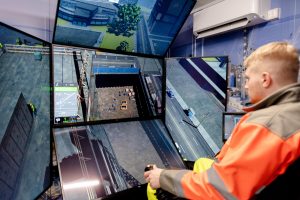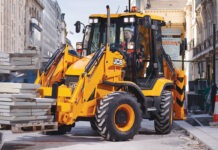It’s no secret that the avenues that used to bring in construction recruits are being choked off. For one thing, the younger generation has been streamed into white collar jobs for decades now. For another, kids today simply don’t have the same access to heavy equipment their parents did.
The cherry on the sundae is that today’s recruits simply have wildly different expectations of what awaits them on the worksite, compared to previous generations.
The result is a vast shortfall in the skills of available workers, which is compounded by existing challenges faced by construction firms, including the high cost of training procedures, as well as limited training resources.
The impact is playing out in hefty figures. According to the Conerstone, in the United Kingdom, 50% of all projects have been delayed because of labour shortages. Numbers from McKinsey suggest that 41% of the construction workforce is expected to retire by 2031 — which puts into sobering perspective that an estimated 60% of injuries happen during a worker’s first year of experience. This potent combination of experienced workers leaving and new workers potentially getting hurt just makes it even more difficult to get any work done.
New Approach Prepares Trainees to Hit the Ground Running
Leading construction firms are responding by investing in better training programmes for large pools of primarily unqualified candidates — including the use of immersive simulation training technology that makes it possible for them to tap into more flexible strategies.
Immersive simulation technology makes you feel “like you’re there” – in the machine, on the job, and under real conditions. There are numerous safety benefits associated with the use of such tools, the most critical being that trainees can experience life-like situations in complete safety – and even prepare for potentially risky situations.
It’s important to be able to use immersive simulation technology to “cross that line on purpose,” says 20-year veteran instructor Gary James. “My first time tipping over a full-sized excavator taught my body a lot of lessons that make me a much safer plant operator.”
Other outcomes of simulation technology impact trainees well before they even get close to a real piece of equipment, including improved situational awareness and improved confidence levels, so trainees can hit the ground running when they get to the real machine.
Ultimately, with simulation technology, says James, “an instructor can guide you and sit right there with you in the passenger seat – even if the real equipment doesn’t have a passenger seat.
Why Some Simulation Experiences are More Immersive than Others
According to the dictionary, the opposite of “immersive” is “shallow,” “boring,” and “tedious.” That is precisely why companies such as CM Labs work so hard to create an engaging experience that allows novice plant operators to train as though they were in the real thing – and to acquire valuable skills in the process.
The key to creating such immersion is CM Labs’ focus on the full sensory experience of operating heavy equipment:
- Visual immersion supports the idea that you’re actually in the working environment through screens that fill your field of view, as in a cinematic experience.
- Motion immersion gives you the physical sense that your equipment is moving through the environment. Actuators provide an experience of tilt and vibration, from large movements to smaller, more subtle movements.
- Auditory immersion includes cues such as the sound of wind, rain, ambulances, sirens, thunder, and other noises, on top of actual machine sounds.
- Haptic immersion incorporates the sense of touch, as when you’re digging and feeling the resistance of the dirt, or the force feedback from controls or steering wheels.
- Contextual immersion is provided by training exercises that are identical to real-world worksite applications.
You can actually see how these different elements of immersiveness add up, according to Gary James. “If a veteran operator hears the wind you’ve injected into the scenario, they may change their grip or their body position in the seat, helping themselves get into a comfortable position to hold left or hold right.”
“Even during demos, within 15-20 minutes you’ll notice plant operators looking behind them before they reverse, due to how real it feels in their body.”

Simulation gets Physical, Thanks to … Engineering
Almost as much engineering goes into simulation training technology as the equipment it’s simulating. The payoff is tremendous, from authentic machine behavior to simulated tires behaving like real tires, and dirt that feels like dirt.
After all, says Alan Limoges, CM Labs’ Manager of Strategic Partnerships, “if the soil doesn’t feel right, the machine won’t feel right. The roll of the dirt and the way it folds over has a feel that’s captured in the sim.”
With center of gravity calculations baked into the technology, he adds, trainees experience the full spectrum of operating risk – and gain the proper respect for their equipment.
Likewise, fuel data models can help measure how hard operators are being on the machine — which allows instructors to compare students and create teachable moments. They can even identify when plant operators are adding throttle or brake or engine retardation, as the training system captures each pedal movement and each button press.
Every detail matters – even tire bounciness is reproduced in the simulator. This has an impact that carries over to the worksite, says Gary James.
“Whether you’re operating a wheel loader or a backhoe, if you’re using them to transition materials, spillage will accumulate. With realistic tire simulation, you’ll feel everything as you drive over, making your training that much more physical.”
Christa Fairchild, CM Labs’ Construction Product Marketing Manager, adds, “the engineering quality of the training solutions means you’re capturing accurate operating metrics, which in turn means you can properly benchmark plant operators, for example, by estimating operating cycle times and fuel consumption as well as rate of change as their training progresses.”
It’s this attention to detail that sets such simulation training solutions apart, and avoids the “negative training” trap you might encounter in lower fidelity experiences.
“Training needs to prepare the body to be ready with natural reactions to events in the real world,” says James, “whether it’s checking the landing gear, booming down, or whatever the moment calls for.”
Training Technology is Paying its Own Way
Although simulation training technology is not cheap, the savings quickly add up.
For example, CM Labs client Conewago Enterprises reports a 40% increase in productivity, thanks to structured use of simulation in their training programme. The training itself is also accelerated due to the concentrated “seat time” – as much as 45% to 70% faster, which means a plant operator is contributing to profitable operations that much quicker. Other clients report 17% less equipment usage in training, which naturally reduces maintenance costs as well as the risk of injury or other worksite incidents.
The savings don’t stop there. With industry sources citing the cost of rework at approximately 9% of project costs, and OSHA benchmarking $4 to $6 saved for every dollar invested in safety, there is a powerful business case for tools that essentially brick off the chances of training incidents, delayed or halted projects, insurance rate hikes, or workers comp payouts.
Organisations also can use simulation technology to pre-screen plant operators instead of injecting unknown commodities into an active worksite, says Gary James. However, he adds, the real payoff of immersive training solutions is in the value they provide to instructors and training groups. “One day on the sim is equal to a week or more in the field due to the number of scenarios you can go through,” he says.
“Not only that, but plant operators who may be retiring or already retired can pass down their experience, as they sit next to the simulator and ‘co-pilot’ new operators.”
All told, it’s an innovative solution designed to stack the deck firmly in the favour of construction firms as they prepare a new generation of plant operators for today’s work sites.
New simulation training strategies are transforming skills development today. Learn more in an informative 60-minute recording of a webinar moderated by Construction Business Owner magazine, and featuring 20-year veteran instructor Gary James, with Alan Limoges and Christa Fairchild, CM Labs construction experts. [watch now]








